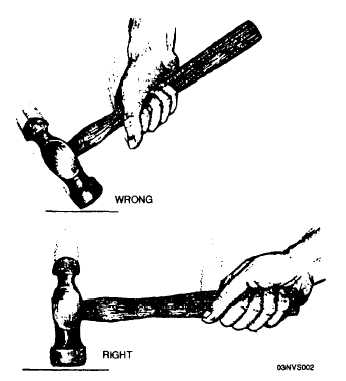Most soft-faced hammers have heads that can be
replaced as the need arises. Lead-faced hammers, for
instance, quickly become battered and must be
replaced, but have the advantage of striking a solid,
heavy nonrebounding blow that is useful for such jobs
as driving shafts into or out of tight holes. If a
soft-faced hammer is not available, the surface to be
hammered may be protected by covering it with a
piece of soft brass, copper, or hard wood.
Using Hammers
Simple as the hammer is, there is a right and a
wrong way of using it.
(See fig. 1-2.) The most
common fault is holding the handle too close to the
head. This is known as choking the hammer, and
reduces the force of the blow. It also makes it harder
to hold the head in an upright position. Except for
light blows, hold the handle close to the end to
increase leverage and produce a more effective blow.
Hold the handle with the fingers underneath and the
thumb along side or on top of the handle. The thumb
should rest on the handle and never overlap the
fingers. Try to hit the object with the full force of the
hammer. Hold the hammer at such an angle that the
face of the hammer and the surface of the object being
hit will be parallel. This distributes the force of the
blow over the full face and prevents damage to both
the surface being struck and the face of the hammer.
MALLETS AND SLEDGES
The mallet is a short-handled tool used to drive
wooden-handled chisels, gouges, and wooden pins, or
to form or shape sheet metal where hard-faced
hammers would mar or damage the finished work.
Mallet heads are made from a soft material, usually
wood,
rawhide,
or rubber.
For example, a
rubber-faced mallet is used for knocking out dents in
an automobile. It is cylindrically shaped with two flat
driving faces that are reinforced with iron bands. (See
fig. 1-1.) Never use a mallet to drive nails, screws, or
any other object that can damage the face of the
mallet.
The sledge is a steel-headed, heavy-duty driving
tool that can be used for a number of purposes.
Short-handled sledges are used to drive driftpins, and
large nails, and to strike cold chisels and small
hand-held rock drills. Long-handled sledges are used
to break rock and concrete, to drive spikes or stakes,
and to strike rock drills and chisels.
made of a
Figure 1-2.-Striking a surface.
The head of a sledge is generally
high-carbon steel and may weigh from 2 to 16
pounds. The shape of the head will vary according to
the job for which the sledge is designed.
MAINTENANCE OF STRIKING
TOOLS
Hammers, sledges, or mallets should be cleaned
and repaired if necessary before they are stored.
Before using them, make sure the faces are free from
oil or other material that would cause the tool to
glance off nails, spikes, or stakes. The heads should
be dressed to remove any battered edges.
Never leave a wooden or rawhide mallet in the
sun, as it will dry out and may cause the head to
crack. A light film of oil should be left on the mallet
to maintain a little moisture in the head.
The hammer handle should always be tight in the
head. If it is loose, the head may fly off and cause an
injury.
1-3



